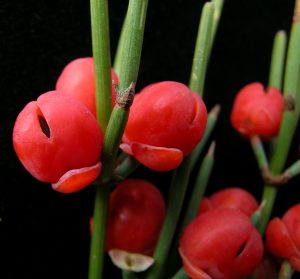A high altitude plant used to treat altitude sickness
 Ephedra is the source of the drug ephedrine, and it has been used in Chinese medicine to treat respiratory complaints since at least 5000 BC. Ephedrine is a bronchodilator and it raises heart rate and blood pressure. Due to these properties, ephedrine has become a popular additive in nutritional supplements to enhance athletic performance and promote weight loss. In Nepal the juice extracted from Ephedra is added to bathing water to treat skin complaints. It is also considered useful in cardiac and circulatory diseases. A powder of the plant is taken to treat asthma, hay fever and respiratory infections. Fresh or dried berries can be chewed to overcome altitude sickness.
Ephedra is the source of the drug ephedrine, and it has been used in Chinese medicine to treat respiratory complaints since at least 5000 BC. Ephedrine is a bronchodilator and it raises heart rate and blood pressure. Due to these properties, ephedrine has become a popular additive in nutritional supplements to enhance athletic performance and promote weight loss. In Nepal the juice extracted from Ephedra is added to bathing water to treat skin complaints. It is also considered useful in cardiac and circulatory diseases. A powder of the plant is taken to treat asthma, hay fever and respiratory infections. Fresh or dried berries can be chewed to overcome altitude sickness.
This plant was collected by Oleg Polunin, an amateur botanist who accompanied a British mountaineering expedition to Nepal in 1949. This was just after the fall of the Rana dynasty, when Nepal suddenly became open to foreigners for the first time. Botanists were keen to enter new regions, and joining mountaineering expeditions was the ideal way to reach remote areas. In those days there were no roads in the mountains, so all expeditions had to walk from Kathmandu – the perfect way for a botanist to collect plants from a wide range of altitudes and habitats!
